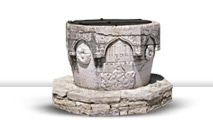
- Sečovlje Salt Pans - Dragonja River Valley
- Sv. Peter - Nova vas - Padna
- Pomjan - Nature Park: Karst Edge - Socerb
- Črni Kal - Osp - Kubed
- Momjan - Grožnjan - Pietrapelosa - Mirna
- Baštija - Kostanjica - Parenzana
- Oprtalj - Završje - Livade - Zrenj
- Istarske toplice - Motovun Forest - Višnjan
- Cave Mramornica - Feštini Kingdom - Cave Baredine
- Lim Bay - Kloštar - Kontija - Dvigrad
- Kanfanar - Bale - Palud - Vodnjan - Brijuni - Fažana
- Svetvinčenat - Tinjan - Pićan - Gračišće
- Belaj - Šumber - Kožljak - Paz
- Čepićko Field - Kršan - Boljun Castle - Lupoglav
- Plomin - Kvarner Gulf - Brseč
- Nature park Učka - Mošćenice
Kanfanar - Bale - Palud - Vodnjan - Brijuni - Fažana
Palud
The only ornithological park in Istria lies between Rovinj and Bale. The swamp developed by melting of the ice and flooding of karst valley, and was mostly filled with fresh water from the source and smaller flows nearby and the surrounding forests and pastures. In the rainy period it covers an area of 20 hectares, while in the dry period it is considerably smaller - only two hectares, with knee-deep water.
During the Austro-Hungarian rule, a canal was dug from the swamp to the sea in order to increase the salinity of the water in the swamp and thus prevent the development of mosquito larvae, transmitters of malaria. By connecting the sea and the swamp, Palud attracted new inhabitants such as the grey mullet and eel, fish that like brackish water, but also others that came in search of food. The diversity of species and the number of resident or migratory bird species are the most important feature of this swamp. Its greatest part is covered with reed, sedge and bull-rush, surrounded by dense woods with striking specimens of downy oak and holm-oak while its northern part is a true rainforest with huge willows falling and rotting in the swamp water creating food for the animals. The water temperature is in harmony with the atmosphere, from 5 – 32 0C, being the lowest in March and the highest in July. A characteristic of the swamp is poor oxygenation, especially in the summer. Its level depends on the sea level, while the bottom never dries out because of the inflow of seawater. Due to extreme conditions of life, the swamp developed a characteristic water fauna with a small number of species, each represented in large numbers. It is rich in plankton, and turtles and eels are present all year round.
We must not forget – Palud is inhabited with more than 200 bird species.















